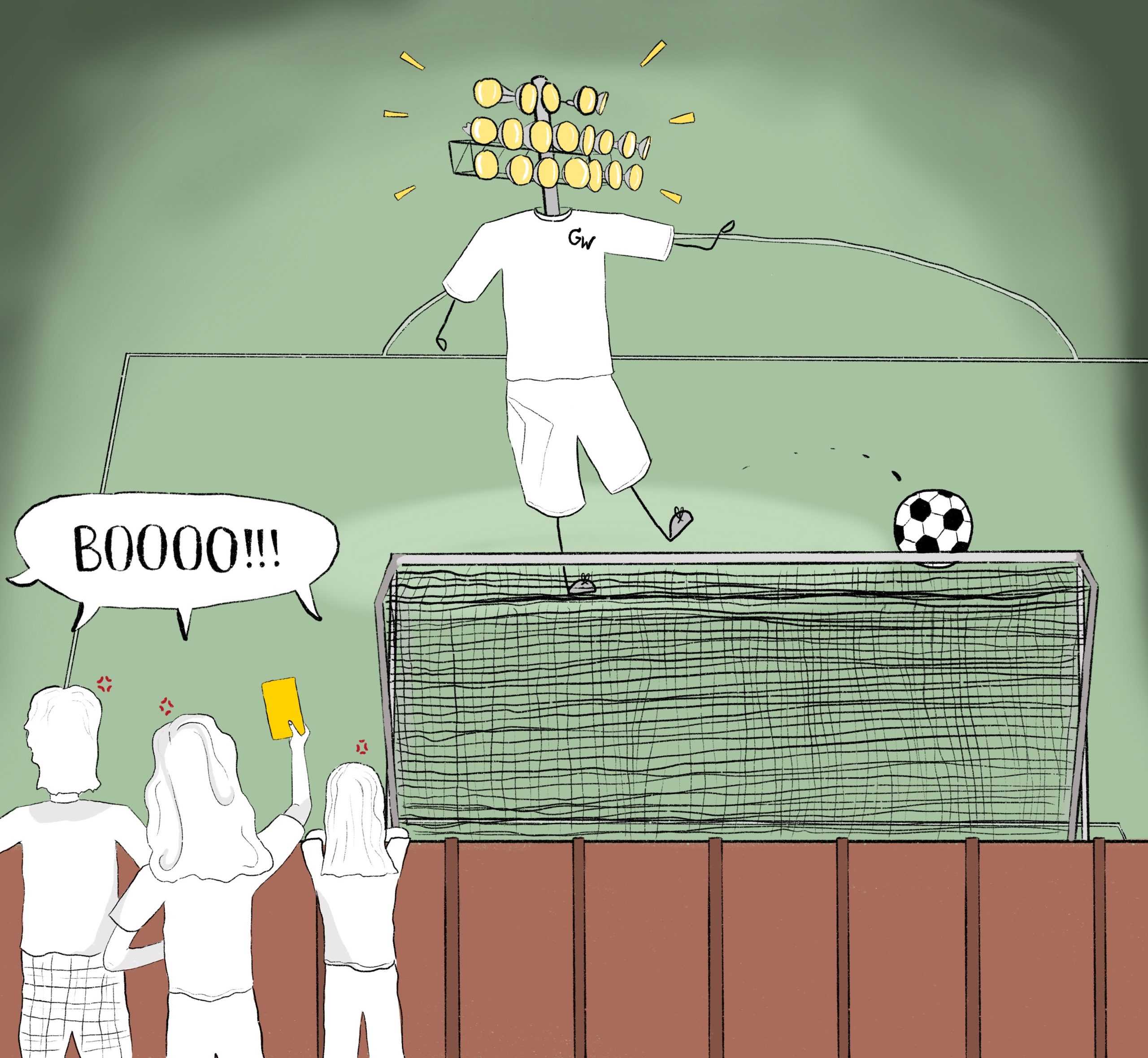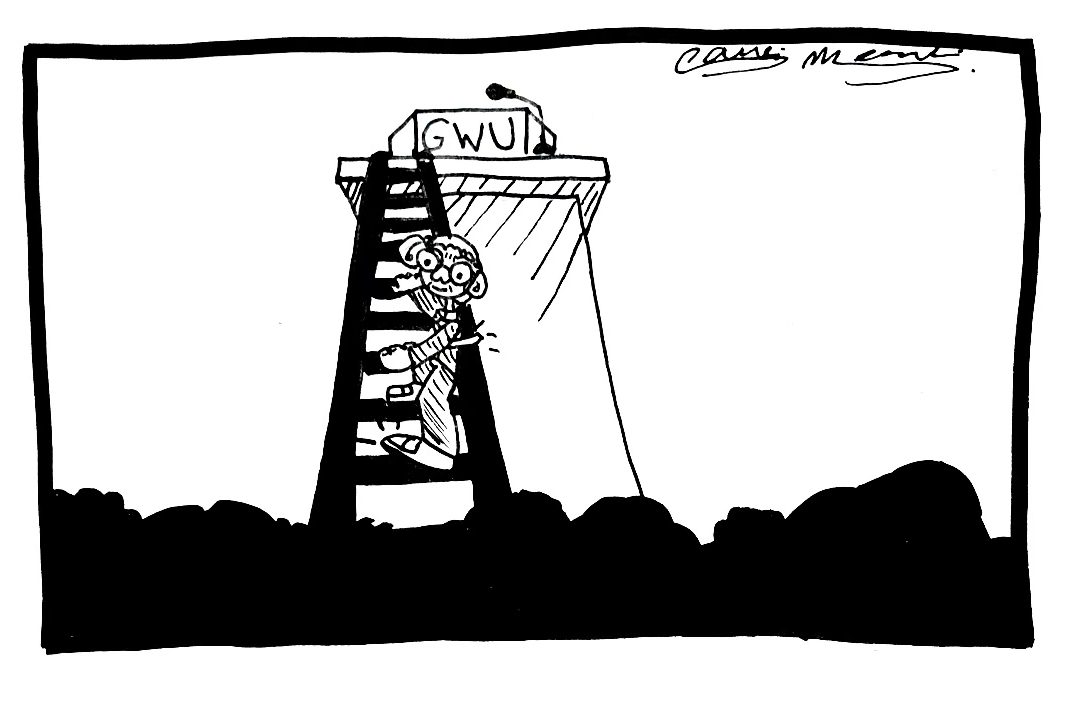As twilight turns to dusk on the Mount Vernon Campus, students continue on to class while tennis balls soar from court to court. The night is young but, suddenly, all over for most outdoor student-athletes – it’s 5 p.m., and the turf is dark.
Though massive stadium lights illuminate the Vern’s tennis courts at night, I found that GW is the only institution in the Atlantic 10 without lights at its varsity lacrosse or soccer field, according to the websites of the athletic programs for the conference’s 15 colleges and universities. GW’s varsity women’s lacrosse, men’s soccer and women’s soccer teams must practice and play home games during daytime hours only, competing for time on the turf alongside 18 club sports teams. With classes during the day and no lights at night, club teams have no way to make safe use of the University’s only outdoor practice space.
The Vern’s neighbors have long stood in the way of stadium lighting for the synthetic turf soccer and lacrosse field due to fears of noisy night games and bright lights in their windows. The Foxhall-Palisades Advisory Neighborhood Commission threatened to delay D.C. Zoning Commission hearings during GW’s proposed Vern renovations in 2010, and neighbors successfully spoke out against turf light installation at community meetings that GW officials co-led in 2021. But varsity and club student-athletes can help change neighbors’ minds. As leaders of a lights-focused advocacy campaign, students should share their perspective as athletes seeking adequate opportunities for competitive success. Grassroots advocacy certainly sounds like a long shot, but GW’s student-athletes can band together over a common goal.

Maura Kelly-Yuoh | Staff Cartoonist
Varsity teams take priority over their club counterparts for turf reservations, so when the field’s strained schedule fills up, there often aren’t enough hours in a day to accommodate every club team’s practices. Instead, these teams can choose from dog parks or elementary school fields to practice for their games with some local vicinity to campus. And as students continue to endure another dark winter in the District, club teams have fewer outdoor practice options that sponsor visible field conditions – a predicament that could become dangerous rather quickly.
GW officials recognize the need for greater field space, but any effort to improve the University’s athletic facilities seems incomplete without a plan to install lights at the Vern’s turf. The pinch for practice space forces club teams to spend more than 250 hours traveling to off-campus fields every year. GW’s partnership with The St. James, a luxurious indoor athletic complex in Springfield, Virginia, allows the University to rent late-night practice space for club teams during the week. While GW’s help, including subsidized transportation to and from the complex for weeknight practices, certainly creates more practice opportunities for club sports teams, the fix is temporary at best, circuitous at worst and costly all of the time.
Despite its plans to vastly improve the Vern’s campus over the next decade, GW’s administration wrongly conceded to continue not lighting the turf during talks with the campus’ neighbors in 2021. D.C. requires colleges and universities like GW to submit development plans to the Zoning Commission for approval, and GW’s 2022 Campus Plan for the Vern included the installation of lights at the school’s softball field and a proposal to convert the tennis courts – already equipped with LED lighting – to a running track with a multipurpose infield for student use. These projects will demonstrably improve field availability in the distant future but leave students who use the soccer and lacrosse field in the dark.
After a history of rocky relations that began with the University’s initial acquisition of Mount Vernon College in 1998, GW continued to struggle with the Vern’s neighbors over campus development proposals. GW also committed to not light the turf as part of the University’s 2010 Mount Vernon Campus Plan, which still caught backlash from the school’s surrounding community over an increase in the Vern’s student population. And though the University cited club sports’ struggles to find practice space in its most recent push for lighting, community members boasted that a majority of the Vern’s neighbors – roughly 20 people – had signed a petition against lights.
While GW’s campus plan can increase opportunities for student recreation in the distant future, it means club sports teams still won’t have enough time and space to practice on campus into the next decade. We should be able to cheer on our classmates at the Vern, but without lighting, student-athletes must play some of the season’s biggest games during the middle of the afternoon while their biggest fans are stuck in class.
A dedicated group of varsity and club student-athletes should reinvigorate discussions with the Vern’s neighbors and illustrate how a lack of stadium lighting negatively impacts their athletic experiences at GW. Though the Zoning Commission would have to approve text amendments to the current campus plan at a second hearing, students and officials must first work together to swing the Vern’s neighbors toward turf lighting in the meantime.
The move would benefit GW students with a well-lit field and would serve as the ideal venue for a Sunday night football league or youth lacrosse practice. And advancements in lighting technology have lessened the impact of installing light fixtures near private residences, a fact that should assuage concerns about unwanted glare and light intrusion.
A student voice on the need for adequate athletic opportunities might finally shift the tide in a neighborhood that has historically opposed stadium lighting. By sparking discussions with the campus’ neighbors through an organized forum, students can advocate for the installation of stadium lighting with the passion and vigor required for such a momentous decision. The Vern can’t spend another decade in the dark.
Matthew Donnell, a junior majoring in political communication and English, is an opinions writer.


